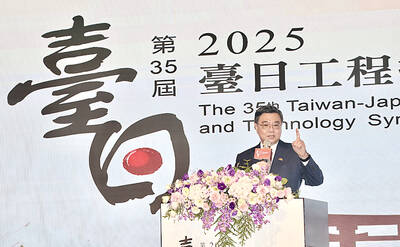A simple health check with the help of a stool color chart could save infants suffering from congenital biliary atresia from deadly liver damage, health officials said, adding that the Taiwan-developed chart has been adopted by many countries.
Since 2004, the Ministry of Health and Welfare has included the “Stool Check Chart” in its Children’s Health Manual to help parents and nurses determine, based on stool color, whether babies are affected with congenital biliary atresia, a disease of the bile ducts that only affects infants.
Bile is a digestive liquid that is made in the liver. It travels through the bile ducts to the small intestine, where it helps digest fats. In biliary atresia, the bile ducts become inflamed and blocked soon after birth. This causes bile to remain in the liver, where it starts to destroy liver cells, causing cirrhosis, or scarring of the liver.
In 2006, Taiwan established the world’s first reporting system for nationwide screening of biliary atresia, encouraging healthcare personnel at hospitals and clinics to perform the examination on 30-day-old infants by asking their parents or caregivers about the color of their babies’ stools.
Over the past decade, 300 infants have been found to have to have bile duct abnormalities and liver dysfunction through use of the stool color check, officials from the ministry’s Health Promotion Administration said.
The infants were treated and had bile drained, the officials said, adding that without such treatment, infant biliary atresia can easily develop into liver cirrhosis, which can lead to death within two years.
According to the HPA, about 200,000 babies are born in Taiwan every year, 30 to 40 of whom have biliary atresia.
National Taiwan University Hospital professor of pediatrics Chang Mei-hwei (張美惠), who in 2002 developed the chart with the administration, said that from 1976 to 2000 — before the chart had been distributed — the percentage of infants with biliary atresia who received the Kasai procedure — surgery to drain bile from the liver — within the first 60 days of birth was 35.6 percent.
The percentage increased to 65.8 percent in the period from 2004 until last year, Chang said.
Moreover, after tracking biliary atresia cases, the five-year survival rate of patients who have not received a liver transplant climbed from 37.5 percent in 1999-2000, before the circulation of the nine-color chart, to 64.3 percent in 2002-2005, Chang said.
The total five-year survival rate has surged from 55.7 percent to 89.3 percent, Chang added.
The results were published in the Journal of Hepatology in 2008, since when countries, including the US, the UK, Canada, New Zealand, Switzerland, the Netherlands, Oman, Thailand, Philippines, Malaysia, Israel and Mexico have asked to use the chart or conduct research on it, the ministry said.

LOW RISK: Most nations do not extradite people accused of political crimes, and the UN says extradition can only happen if the act is a crime in both countries, an official said China yesterday issued wanted notices for two Taiwanese influencers, accusing them of committing “separatist acts” by criticizing Beijing, amid broadening concerns over China’s state-directed transnational repression. The Quanzhou Public Security Bureau in a notice posted online said police are offering a reward of up to 25,000 yuan (US$3,523) for information that could contribute to the investigation or apprehension of pro-Taiwanese independence YouTuber Wen Tzu-yu (溫子渝),who is known as Pa Chiung (八炯) online, and rapper Chen Po-yuan (陳柏源). Wen and Chen are suspected of spreading content that supported secession from China, slandered Chinese policies that benefit Taiwanese and discrimination against Chinese spouses of

ALIGNED THINKING: Taiwan and Japan have a mutual interest in trade, culture and engineering, and can work together for stability, Cho Jung-tai said Taiwan and Japan are two like-minded countries willing to work together to form a “safety barrier” in the Indo-Pacific region, Premier Cho Jung-tai (卓榮泰) yesterday said at the opening ceremony of the 35th Taiwan-Japan Modern Engineering and Technology Symposium in Taipei. Taiwan and Japan are close geographically and closer emotionally, he added. Citing the overflowing of a barrier lake in the Mataian River (馬太鞍溪) in September, Cho said the submersible water level sensors given by Japan during the disaster helped Taiwan monitor the lake’s water levels more accurately. Japan also provided a lot of vaccines early in the outbreak of the COVID-19 pandemic,

PROMOTION: Travelers who want a free stopover must book their flights with designated travel agents, such as Lion Travel, Holiday Tours, Cola Tour and Life Tours Air Canada yesterday said it is offering Taiwanese travelers who are headed to North America free stopovers if they transit though airports in Japan and South Korea. The promotion was launched in response to a potential rise in demand for flights to North America in June and July next year, when the US, Canada and Mexico are scheduled to jointly host the FIFA World Cup, Air Canada said. Air Canada offers services to 13 of the 16 host cities of the tournament’s soccer games, including Toronto and Vancouver; Mexico City, Guadalajara and Monterrey in Mexico; Atlanta, Georgia; Boston; Dallas; Houston;

The US approved the possible sale to Taiwan of fighter jet spare and repair parts for US$330 million, the Pentagon said late yesterday, marking the first such potential transaction since US President Donald Trump took office in January. "The proposed sale will improve the recipient's capability to meet current and future threats by maintaining the operational readiness of the recipient's fleet of F-16, C-130," and other aircraft, the Pentagon said in a statement. Trump previously said that Chinese President Xi Jinping (習近平) has told him he would not invade Taiwan while the Republican leader is in office. The announcement of the possible arms